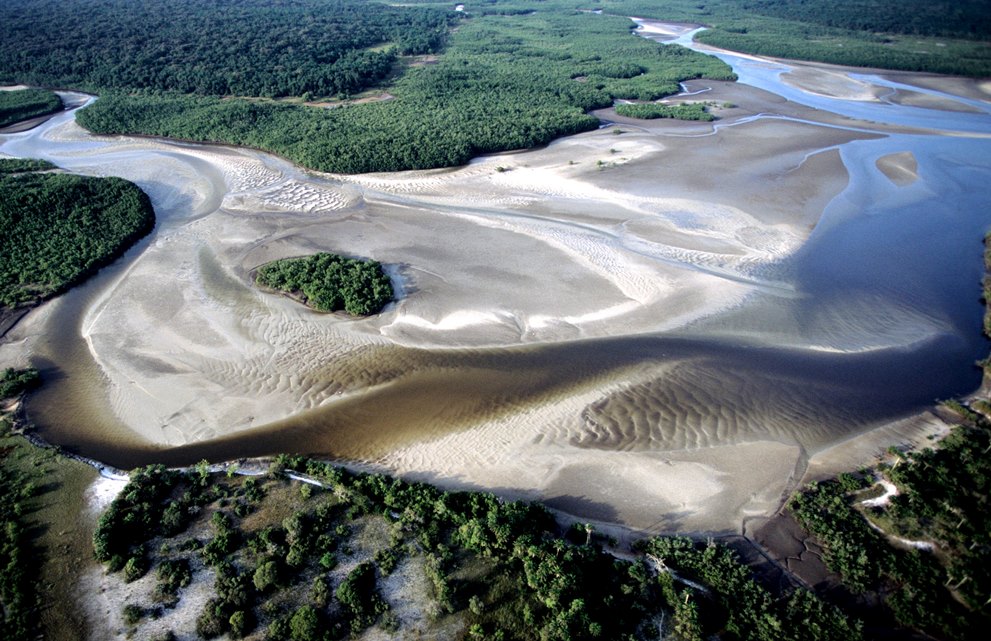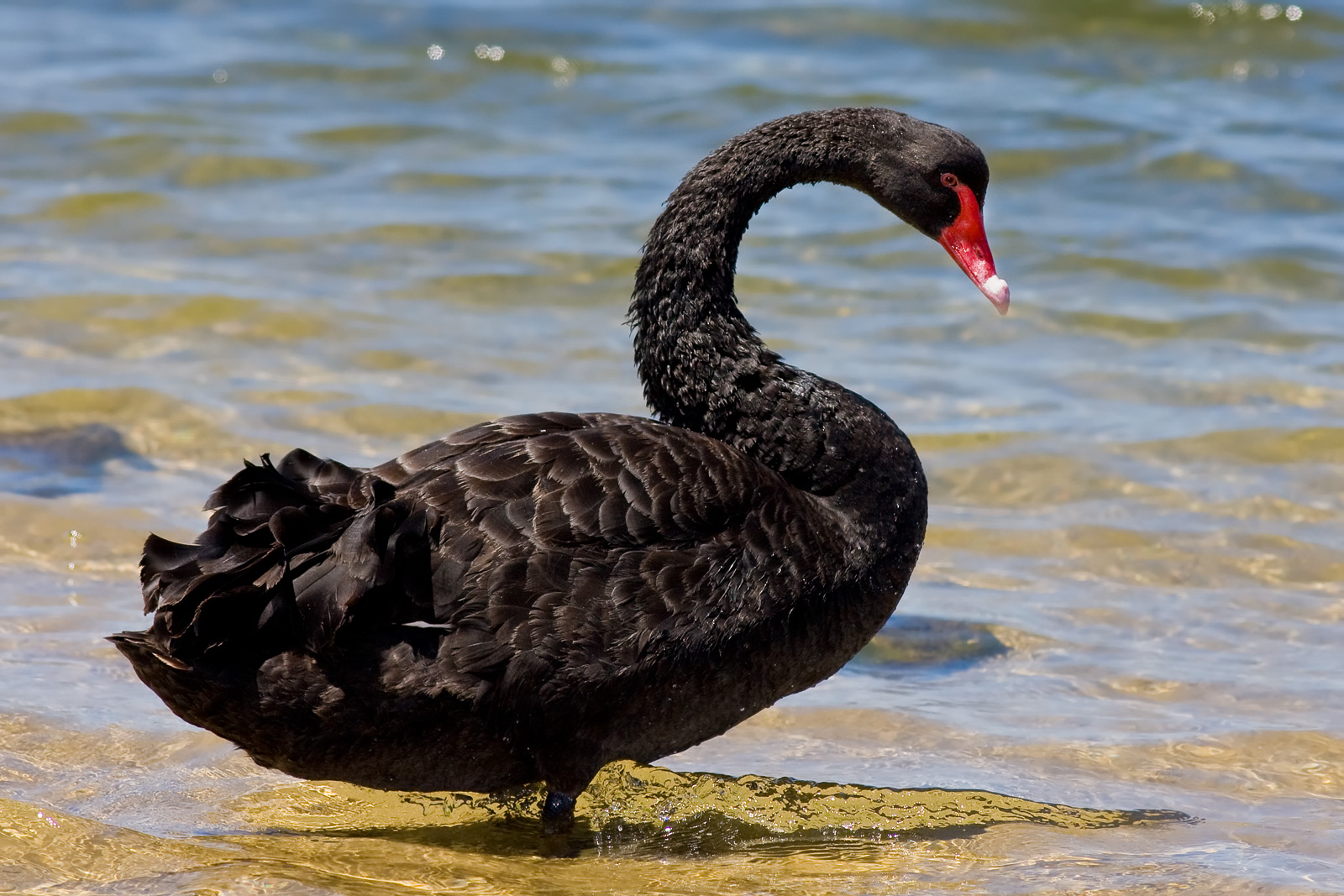|
Vasse-Wonnerup Estuary
The Vasse-Wonnerup Estuary is an estuary in the South West region of Western Australia close to the town of Busselton. The estuary is listed with DIWA. It was also recognised as a wetland of international importance under the Ramsar Convention on 7 June 1990 when an area of was designated Ramsar Site 484 as an important dry-season habitat for waterbirds. It is also the main part of the Busselton Wetlands Important Bird Area. Description The estuary is wave dominated and has been severely modified from its natural state. The site of the Vasse and Wonnerup Floodgates that regulated the flow of water in the estuary from about 1907 inadvertently created the freshwater wetland, were listed on the Western Australian Register of Heritage Places in 2005. The estuary covers a total surface area of with the central basin having an area of In winter, wide areas of open water are fringed by samphire and rushes. Paperbark woodland occurs behind the samphire belt, with eucalypt woodl ... [...More Info...] [...Related Items...] OR: [Wikipedia] [Google] [Baidu] |
Ramsar Convention
The Ramsar Convention on Wetlands of International Importance Especially as Waterfowl Habitat is an international treaty for the conservation and sustainable use of Ramsar site, Ramsar sites (wetlands). It is also known as the Convention on Wetlands. It is named after the city of Ramsar, Mazandaran, Ramsar in Iran, where the convention was signed in 1971. Every three years, representatives of the contracting parties meet as the Ramsar Convention#Conference of the Contracting Parties, Conference of the Contracting Parties (COP), the policy-making organ of the wetland conservation, convention which adopts decisions (site designations, resolutions and recommendations) to administer the work of the convention and improve the way in which the parties are able to implement its objectives. In 2022, COP15 was held in Montreal, Canada. List of wetlands of international importance The list of wetlands of international importance included 2,531 Ramsar site, Ramsar sites in Februa ... [...More Info...] [...Related Items...] OR: [Wikipedia] [Google] [Baidu] |
Vasse River
The Vasse River is a river in the South West of Western Australia Western Australia (WA) is the westernmost state of Australia. It is bounded by the Indian Ocean to the north and west, the Southern Ocean to the south, the Northern Territory to the north-east, and South Australia to the south-east. Western Aust .... The headwaters of the river are in the Whicher Range below Chapman Hill and it flows in a northerly direction through the city of Busselton until discharging into the Vasse Estuary and then the Indian Ocean via Wonnerup Inlet and Geographe Bay. The river is named after French seaman Thomas (Timothée) Vasse, who disappeared in the area in June 1801 during Nicolas Baudin's expedition. It is estimated that 81.5% of the Vasse River catchment has been cleared. See also * Vasse and Wonnerup Floodgates References Rivers of the South West region Busselton {{WesternAustralia-river-stub ... [...More Info...] [...Related Items...] OR: [Wikipedia] [Google] [Baidu] |
Estuaries Of Western Australia
The estuaries of Western Australia (also known as the Inlets of Western Australia) are located along the coastline of Western Australia. The coastline can be considered in three main sections: South coast of Western Australia, south, west, and Kimberley (Western Australia)#Coastline, Kimberley. Some estuarine features carry through all three regions. Wetlands and estuaries of the Southwest Australia, south west region have very similar ecologies and occurrences of biota. South The estuary/inlet names do not necessarily relate to the names of the rivers that flow into them. (This list is along the coast from the east near Esperance, Western Australia, Esperance to the west near Cape Leeuwin.) * Barker * Stokes Inlet * Torradup * Oldfield Estuary * Jerdacuttup * Culham Inlet * Hamersley * Dempster * Fitzgerald * St Marys * Gordon Inlet * Wellstead Estuary * Beaufort Inlet, Western Australia, Beaufort Inlet * Cheyne * Waychinicup * Normans * Taylor Inlet * Oyster Harbour * Torbay ... [...More Info...] [...Related Items...] OR: [Wikipedia] [Google] [Baidu] |
Australian Broadcasting Corporation
The Australian Broadcasting Corporation (ABC) is Australia’s principal public service broadcaster. It is funded primarily by grants from the federal government and is administered by a government-appointed board of directors. The ABC is a publicly-owned statutory organisation that is politically independent and accountable; for example, through its production of annual reports, and is bound by provisions contained within the Public Interest Disclosure Act 2013 and the Public Governance, Performance and Accountability Act 2013, with its charter enshrined in legislation, the ''Australian Broadcasting Corporation Act 1983''. ABC Commercial, a profit-making division of the corporation, also helps generate funding for content provision. The ABC was established as the Australian Broadcasting Commission on 1 July 1932 by an Act of Federal Parliament. It effectively replaced the Australian Broadcasting Company, a private company established in 1924 to provide programming for A ... [...More Info...] [...Related Items...] OR: [Wikipedia] [Google] [Baidu] |
Algae
Algae ( , ; : alga ) is an informal term for any organisms of a large and diverse group of photosynthesis, photosynthetic organisms that are not plants, and includes species from multiple distinct clades. Such organisms range from unicellular microalgae, such as cyanobacteria, ''Chlorella'', and diatoms, to multicellular macroalgae such as kelp or brown algae which may grow up to in length. Most algae are aquatic organisms and lack many of the distinct cell and tissue types, such as stomata, xylem, and phloem that are found in embryophyte, land plants. The largest and most complex marine algae are called seaweeds. In contrast, the most complex freshwater forms are the Charophyta, a Division (taxonomy), division of green algae which includes, for example, ''Spirogyra'' and stoneworts. Algae that are carried passively by water are plankton, specifically phytoplankton. Algae constitute a Polyphyly, polyphyletic group because they do not include a common ancestor, and although Eu ... [...More Info...] [...Related Items...] OR: [Wikipedia] [Google] [Baidu] |
Phosphorus
Phosphorus is a chemical element; it has Chemical symbol, symbol P and atomic number 15. All elemental forms of phosphorus are highly Reactivity (chemistry), reactive and are therefore never found in nature. They can nevertheless be prepared artificially, the two most common allotropes being white phosphorus and red phosphorus. With as its only stable isotope, phosphorus has an occurrence in Earth's crust of about 0.1%, generally as phosphate rock. A member of the pnictogen family, phosphorus readily forms a wide variety of organic compound, organic and inorganic compound, inorganic compounds, with as its main oxidation states +5, +3 and −3. The isolation of white phosphorus in 1669 by Hennig Brand marked the scientific community's first discovery since Antiquity of an element. The name phosphorus is a reference to the Phosphorus (morning star), god of the Morning star in Greek mythology, inspired by the faint glow of white phosphorus when exposed to oxygen. This property is ... [...More Info...] [...Related Items...] OR: [Wikipedia] [Google] [Baidu] |
Fish Kill
The term fish kill, known also as fish die-off, refers to a localized mass mortality event, mass die-off of fish populations which may also be associated with more generalized mortality of aquatic life.University of Florida. Gainesville, FL (2005)"Fish kill." ''Plant Management in Florida's Waters.'' The most common cause is reduced oxygen in the water, which in turn may be due to factors such as drought, harmful algal bloom, overpopulation (biology), overpopulation, or a sustained increase in water temperature. Fish diseases and parasites, Infectious diseases and parasites can also lead to fish kill. Toxicity is a real but far less common cause of fish kill, and is often associated with man-made water pollution. Fish kills are often the first visible signs of environmental stress and are usually investigated as a matter of urgency by environmental agencies to determine the cause of the kill. Many fish species have a relatively low tolerance of variations in environmental conditi ... [...More Info...] [...Related Items...] OR: [Wikipedia] [Google] [Baidu] |
Black Swan
The black swan (''Cygnus atratus'') is a large Anatidae, waterbird, a species of swan which breeds mainly in the southeast and southwest regions of Australia. Within Australia, the black swan is nomadic, with erratic migration patterns dependent on climatic conditions. It is a large bird with black plumage and a red beak, bill. It is a Monogamy in animals, monogamous breeder, with both partners sharing incubation and Swan#Etymology and terminology, cygnet-rearing duties. The black swan was introduced to various countries as an ornamental bird in the 1800s, but has managed to escape and form stable populations. Described scientifically by English naturalist John Latham (ornithologist), John Latham in 1790, the black swan was formerly placed into a monotypic genus, ''Chenopis''. Black swans can be found singly, or in loose companies numbering into the hundreds or even thousands. It is a popular bird in zoological gardens and bird collections, and escapees are sometimes seen outside ... [...More Info...] [...Related Items...] OR: [Wikipedia] [Google] [Baidu] |
Australian Shelduck
The Australian shelduck (''Tadorna tadornoides''), also known as the chestnut-breasted shelduck or mountain duck, is a shelduck, a group of large goose-like ducks part of the bird family Anatidae. The genus name ''Tadorna'' comes from Celtic roots and means "pied waterfowl". They have a striking chestnut-coloured breast and black body. They are protected under the National Parks and Wildlife Act 1974. Taxonomy and naming William Jardine and Prideaux John Selby described the Australian shelduck in 1828. Description The males are mostly dark, with a chestnut breast. They have white neck collars and dark green heads. The females are similar, but they have white around the eyes and are smaller. Both males and females have chestnut and black wings with a green speculum, and show some white on their wings during flight. The downy young are white with a brown crown and brown stripes from crown to tail. Juvenile males are duller than the adults and also lack a white collar, whil ... [...More Info...] [...Related Items...] OR: [Wikipedia] [Google] [Baidu] |
Australasian Shoveller
The Australasian shoveler (''Spatula rhynchotis'') is a species of dabbling duck in the genus ''Spatula''. It ranges from . It lives in heavily vegetated swamps. In Australia it is protected under the National Parks and Wildlife Act 1974. They occur in southwestern and southeastern Australia, Tasmania, and New Zealand.Clements, J. (2007) The male has a blue-grey head with a vertical white crescent in front of the eyes. Naming The common name for the species ''Spatula rhynchotis'' is Australasian shoveler no matter which country it is found in. It was previously categorised as two subspecies: * ''S. rhynchotis rhynchotis'' Australian shoveler, the nominate race, occurs in southwestern and southeastern Australia and Tasmania. * ''S. rhynchotis variegata'' New Zealand shoveler, occurs in New Zealand. Other names used include: spoonbill, shoveler, spoony, spoonie and shoveller. The Māori name is kuruwhengi. The Australasian shoveler was described by the English ornithologist ... [...More Info...] [...Related Items...] OR: [Wikipedia] [Google] [Baidu] |
Banded Stilt
The banded stilt (''Cladorhynchus leucocephalus'') is a Bird migration#Short-distance and altitudinal migration, nomadic wader of the stilt and avocet family, Recurvirostridae, native to Australia. It belongs to the monotypic genus ''Cladorhynchus''. It gets its name from the red-brown breast band found on breeding adults, though this is mottled or entirely absent in non-breeding adults and juveniles. Its remaining plumage is Piebald, pied and the eyes are dark brown. Nestling banded stilts have white down, unlike any other species of wader. Breeding is triggered by the filling of inland salt lakes by rainfall, creating large shallow lakes rich in tiny shrimp on which the birds feed. Banded stilts migrate to these lakes in large numbers and assemble in large breeding colonies. The female lays three to four brown- or black-splotched whitish Bird egg, eggs on a Bird nest#Scrape, scrape. If conditions are favourable, a second brood might be laid, though if the lakes dry up prematur ... [...More Info...] [...Related Items...] OR: [Wikipedia] [Google] [Baidu] |




